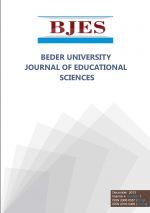
“Mestiza” Daughters and Cultural Electras: Transborder Matrilineage in Rebecca Walker’s Black, White and Jewish (2000
Abstract
This paper is a qualitative analysis of the cultural notion of the “mestiza” daughter and of the way the lines of transborder matrilineage spread through Rebecca Walker’s Black, White and Jewish. The cultural ‘Mestizas’ try to strike a balance in between their insider and outsider status in the society for then coming to terms with their multiple identities and adopting the role of cultural ambassadors. In this autobiography Rebecca Walker is revealed transforming herself from a rebellious black adolescent living with her mother in the bohemia of San Francisco to an upper middle class Jewish girl living with her father and her stepmother in the suburbs of Manhattan. Shuttling between coasts and cultures makes Walker feel a “movement child” psychologically, physically and politically. At times feeling completely at home in her mother’ s world, other times going through disruption from the mother as a way of waging war on her search for identity, Rebecca maps up her identity through the “Mestiza Daughter” and the “Cultural Electra” trope. Literally traveling between two or more worlds and developing a tolerance for contradictions and plurality, the “Mestiza” is involved in self-negotiations and mediations that make her side with the dominant culture instead of identifying with the matrilineal heritage or becoming a cultural replica of the Electra complex. Typical of the matrilineal relationship in Rebecca Walker’ s Black, White and Jewish is the matrophobic rejection of the mother’s peculiarities and the desire to become purged once and for all from the remnants of her culture. Considering her mother as the inner scapegoat and the inherent blemish, Rebecca recognizes failure to live up to the societal standards of good mothering and turns to her father as a point of reference for her life. Nevertheless, there seems to be no place for a biracial, multiethnic daughter in the xenophobic society of the father, and this makes Rebecca decide to discharge the father’s surname and highlight the mother’s one as a sign of privileging blackness and downplaying whiteness. Walker’s perpetually shifting locations create a narrative that partakes of fact and iction, fantasy and experience, storytelling and collective unconscious, and present the protagonist as a compulsory amnesiac absorbed in the shapelessness of identity, time and location.
Absorbed in an existence which is void of daily routines, and inding permanence only in the transitional accommodation of airports, Rebecca will claim and disclaim separate parts of her character in every new location periodically moving from the East Coast to the West Coast, from the white Jewish suburbia to the black artist bohemia, from the white outsiderhood to the black insiderhood. Stylistically speaking the author has intentionally capitalized Home because no conventionality of space or attitude can deserve that name. She feels content with an off the map position and as a mediator.
Rejecting the existence of a stabilized and uniied identity and considering herself the tragic mulatta caught between both worlds like a proverbial deer in the headlights, Walker grows aware of her binary marginality and asserts that identity emerges not when identiication is made, but when it fails to be made. The sense of multiplicity conferred by Jewishness refers to the potential to transcend dichotomies such as black and white and leave other facets unarticulated.
Keywords
Black Female Autobiography; Cultural Mestizas; Matrilineal Heritage; Cross Cultural Mediator; Multiple Identities
Authors
Tidita ABDURRAHMANI
Download Article

This work is licensed under a Creative Commons Attribution 4.0 International License.
Warning: mysql_free_result() expects parameter 1 to be resource, null given in /var/www/journals/bjes.beder.edu.al/article.php on line 45